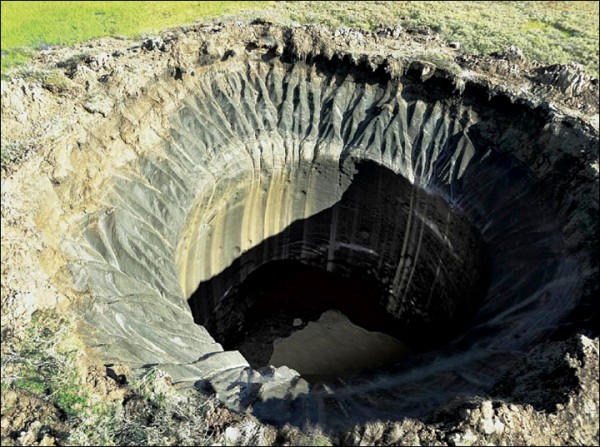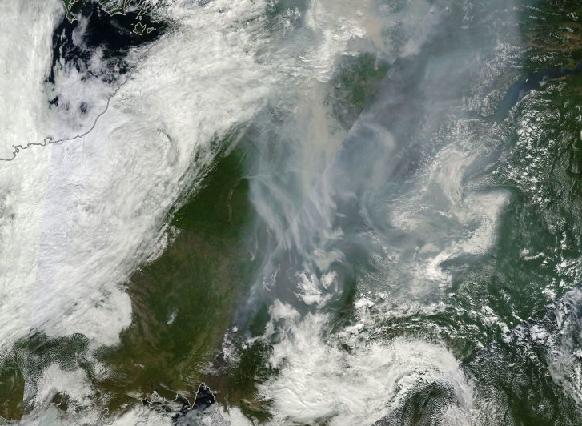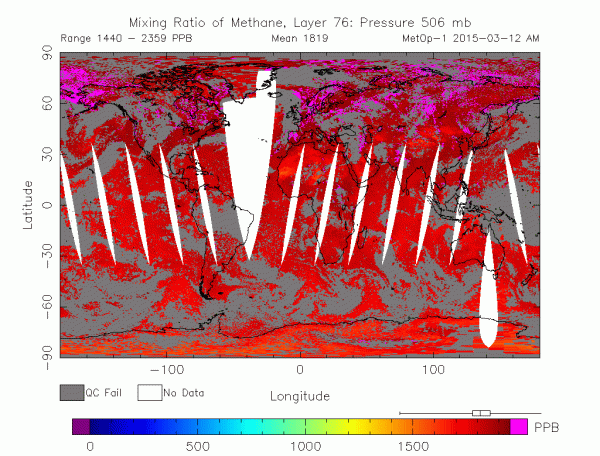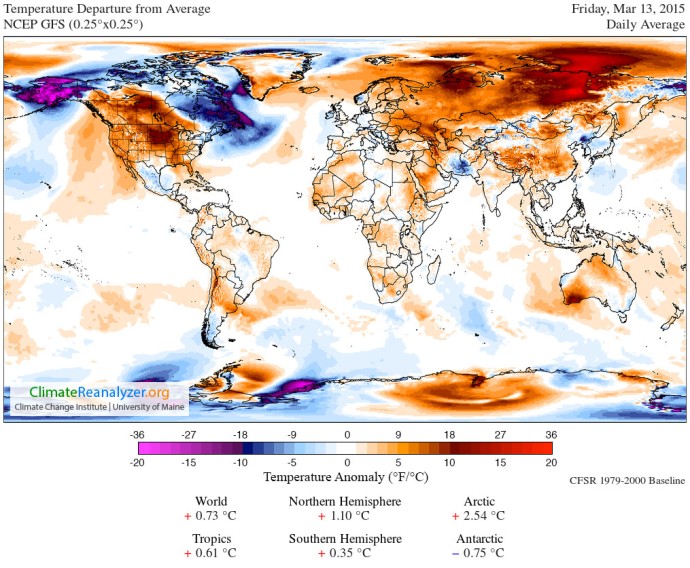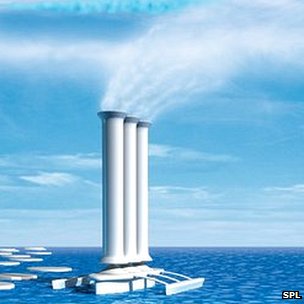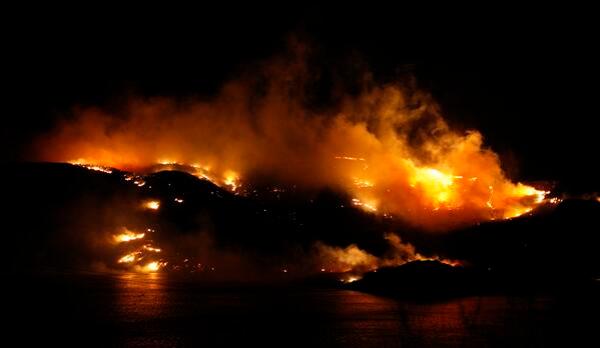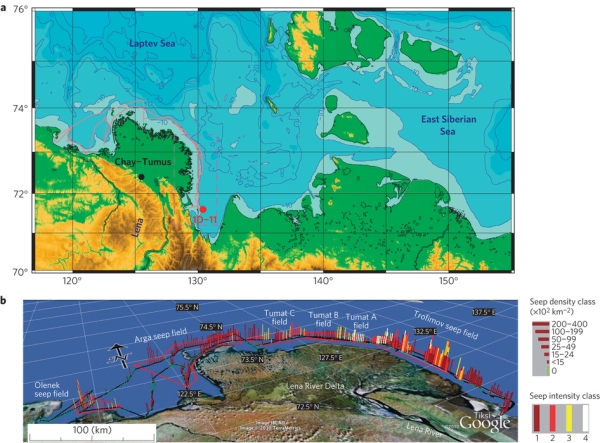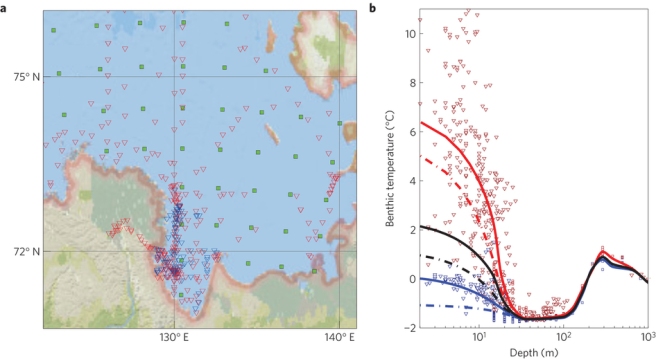Ever since 1995 and especially since 2007 Arctic sea ice area, volume and extent have been in rapid free-fall. By 2012 both sea ice area and extent had suffered losses greater than 55% when compared to end summer measures in 1979. Sea ice volume, meanwhile had shown a stunning loss of nearly 80% from 1979 volume observations. This staggering trend of losses means that any melt year comparable to 2007, 2010 (volume) or 2012 would result in the total or near total loss of all sea ice within the Arctic by end of summer.
The summer of 2013 was exceptional in that it was the first year that statistical averages indicated a potential for total summer sea ice loss. The risk at the time was considered to be low, only 10%. But the figure was historic in that, never before, had a statistical risk of total sea ice loss been identified. Following more typical trends, the 2013 melt season showed a bounce-back from 2012’s record melt year with levels roughly correlating with those seen in 2009. That said, even 2013’s pseudo-recovery did little to disturb an extraordinarily powerful melt trend:

(Sea Ice Volume Measurements For All Months as Observed By PIOMAS With Exponential Trend. Image source: Wipneus. Note that the exponential trend shows monthly volume measures for July, August, September and October reach zero sea ice volume all before 2019.)
Taken into context, the 2013 melt season was little more than a counter-trend year in a period of ongoing and apparently inexorable decline. In context to these massive losses, the heat forcing in the Arctic continues to grow with most regions showing at least a doubled rate of temperature increase when compared to the global norm. Total temperature change in the Arctic is now about 2 degrees Celsius hotter than the 1950 to 1980 global average. A recent study of the regions around Baffin Island showed temperatures are now hotter than at any time within at least the last 44,000 years and probably the last 120,000 years. And with temperatures rising by about .4 degrees Celsius each decade, the Arctic continues to rapidly transition toward ever more hot and unfamiliar territory.
A High Resolution Climate Model For An Arctic in Rapid Transition
These rapid and massive changes appear to have left conventional global climate models (GCMs) in the dust. Earlier global climate model runs of the Arctic assumed slow responses to temperature increases by the world’s ice sheets resulting in predictions for ice free Arctic Ocean conditions at much higher temperatures than those currently being observed. The result of these assumptions that Arctic sea ice generated high inertia and was more resilient to human caused climate change were predictions for ice free Arctic summers to hold off until at least 2100.
But, as we have seen in the above analysis, recent events have put the possibility for ice free Arctic conditions on a much shorter time-scale. And, until recently, only statistical analysis, exponential trends fitting, and direct observation were able to provide any direct guide that more closely fit the stark and ongoing changes in the Arctic. In a world where simulative models seemed to take precedence over even observed reality, the dearth of models describing what all could plainly see was a catastrophic and rapid melt trend cast doubt on the all-too-stark observations.
Now, a new tool to place these much more rapid than expected melt conditions into context appears to be coming together. The high resolution Regional Arctic Systems Model (RASM) constructed by US Navy Scientist Professor Wieslaw Maslowski finds its basis in a 2012 paper showing the potential for the Arctic to be ice free come 2016 +/- 3 years. This new model takes into account a more detailed summary of Arctic conditions including a more highly resolved interpretation of the impacts of warming-driven changes to:
“… sea ice deformation, ocean eddies, and associated ice-ocean boundary layer mixing, multiphase clouds as well as land-atmosphere-ice-ocean interactions.”
Dr. Maslowski notes that while no climate model simulation is perfectly accurate, the RASM simulation is likely to be much closer to what is actually happening in the Arctic environment. Maslowski notes:
“Given the estimated trend and the volume estimate for October–November of 2007 at less than 9,000 km3, one can project that at this rate it would take only 9 more years or until 2016 ± 3 years to reach a nearly ice-free Arctic Ocean in summer. Regardless of high uncertainty associated with such an estimate, it does provide a lower bound of the time range for projections of seasonal sea ice cover.”
It is important to note that RASM hasn’t yet run or provided projections. But the fact that it is taking into account the visibly rapid loss of sea ice as well as a more refined view of the Arctic environs means that such a tool could well generate more accurate measures or at least help explain the apparently very rapid melt trend. According to Maslowski:
“We do expect to compare sea ice volume results [from the RASM model] with our earlier model for the same period … possibly next year or so…”
Confirmation of the Most Pessimistic Predictions?

(2007 and 2012 record sea ice minimums — overlay. Image source: NSIDC)
Dr. Maslowki’s paper and RASM model runs may provide single source confirmation for some of the most pessimistic predictions by Arctic sea ice experts. Dr. Peter Wadhams, a world renown sea ice expert who has spent about 30 years monitoring the state of sea ice aboard British Navy submarines has projected that the Arctic could reach an ice-free state by the end of summer during 2015 or 2016.
Another climate expert, Dr. Carlos Duarte, head of the Ocean Institute at the University of Australia, has projected that the Arctic will reach an ice free state by 2015.
More moderate projections place total sea ice loss during summer at between 2025 and 2040.

(IPCC Global Climate Model Sea Ice Melt Projections. Figures are in Sea Ice Extent (not Volume as seen Above). It is worth noting that the Volume and Area melt trends are much more pronounced than the extent measure that fails to count holes in the ice (area) or add in the measure of ice thickness (volume). The above image, produced by Overland and Wang, also appears to be off the 2012 minimum extent measure by about 200,000 square kilometers.)
Meanwhile, global climate models (GCMs), provided above, continue to lag real time observation, and projections by noted experts. Even taking into account models that have gotten the current trend mostly correct show ice free conditions by around 2050 (mean). Meanwhile, the GCM overall mean continues to show near ice-free conditions by 2100.
These projections are questionable for a number of reasons, not the least of which is the fact that they only take into account the very low resolution of sea ice extent and not the higher resolution figures of sea ice area or volume. Sea ice area, for example, fell to a stunning record low of 2.1 million square kilometers during 2012, a total loss of about 3.6 million square kilometers since 1979 and a loss of about 1 million square kilometers off the previous record low (area) set in 2011. Such a low figure could already, arguably, be called ‘nearly ice free when compared to average area lows of nearly 6 million square kilometers during summers four decades ago.

(Sea Ice Area Measures Provided by NSIDC via Cryosphere Today. Note the extreme record low set in 2012, a measure well below comparable sea ice extent figures which fail to account for holes in the ice. See also: Arctic Ice Graphs.)
It is this lack of GCM resolution, combined with an ongoing trend of stunning losses that has resulted in serious changes in predictions by even somewhat conservative scientists from the National Snow and Ice Data Center. Professor Mark Serreze of Colorado’s branch of NSIDC, who is skeptical that ice free conditions could be reached as early as 2016, notes:
“I am on record stating that we may lose the summer ice cover as early as 2030, and I stand behind that statement. This is in itself much earlier than projections from nearly all climate model simulations. I would agree with Dr. Maslowski that the IPCC models have shortcomings.”
The question, then, is will higher resolution climate models like Maslowski’s RASM provide a better understanding of what appear to be chaotic, powerful and rapid changes to the Arctic environment well ahead of the previously predicted time-frame?
Loss of Summer Sea Ice to Unleash Amplifying Feedbacks
Because it covers such a large stretch of ocean with a white, reflective surface, sea ice is a primary governor of Arctic and global weather. It keeps the Arctic cool by insulating millions of square kilometers of dark Arctic Ocean waters from the near constant radiation of the polar summer sun.
As the sea ice retreats, more of this dark water becomes exposed to the sun’s rays. Because the ocean surface is dark, it traps most of this light. The result is far greater warming of the Arctic during the summer time.
The loss of sea ice and related ocean warming has a number of knock-on effects. The first is that increasing ocean heat delivers far more energy to the sea bed. In the case of the East Siberian Arctic Shelf, the warming shallow sea is one filled with carbon deposits from a massive expanse of submerged tundra. An estimated 1500 gigatons of methane lay sequestered in thawing permafrost beneath this rapidly warming sea. According to Wadhams, loss of sea ice can add up to 7 degrees Celsius of additional warming to this vulnerable sea bed.
Current estimates provided by Dr. Natalia Shakhova show that around 17 megatons of methane are being released from the ESAS each year. This emission is more than twice that of the entire global ocean system and accounts for about 2.8 percent of the current global methane emission. Given the massive volume of methane stored in the ESAS and the rapid pace of sea ice loss and related ocean warming, this region of the world is more than capable of providing significant additional volumes of this potent greenhouse gas.

(A frothy mixture of methane and sea ice near the East Siberian Arctic Shelf. Image source: Igor Semiletov, The University of Alaska)
Meanwhile, ship based observations show that methane levels at the surface of ESAS waters are a stunning 3800 ppb, about twice the global average:
“Ship-based observations show that methane concentrations in the air above the East Siberian Sea Shelf are nearly twice as high as the global average… Layers of sediment below the permafrost slowly emit methane gas, and this gas has been trapped for millennia beneath the permafrost. As sea levels rose at the end of the ice age, the shelf was once again covered by relatively warm ocean water, thawing the permafrost and releasing the trapped methane… In the short-term… methane has a global warming potential 86 times that of carbon dioxide. (NSIDC)”
More rapid Arctic Ocean warming during summer times also results in more rapid warming of nearby land masses. And recent years have seen a number of extraordinary Arctic heatwaves driving 80+ degree temperatures all the way to the shores of the Arctic Ocean. Rapid warming of this region also results in a rapid thaw of massive volumes of permafrost. The permafrost stores organic material that breaks down into both CO2 and methane, providing additional emissions that enhance an already very rapid human warming. Current emissions from the Arctic tundra system are estimated to be around 17 megatons of methane and hundreds of megatons of CO2. Like the emissions coming from the ESAS, these emissions provide a significant added contributor to the human GHG forcing and will likely continue to provide increasing emissions as the sea ice retreats further.
In addition to the combined amplifying feedback of loss of sea ice albedo and amplifying greenhouse gas emissions from the Arctic, sea ice erosion has now also been shown to have profound effects on the circumpolar Jet Stream. Research by Dr. Jennifer Francis, Dr. Quihang Tang, a number of other scientists, and confirming analysis by Dr. Jeff Masters, has noted a weakening in the Jet Stream caused by a lowering of the temperature differential between the lower latitudes and the poles. The Jet is driven by such high temperature extremes between north and south. But as the higher latitudes warm faster than the temperate zones this temperature differential drops and the Jet Stream weakens. The end result is higher amplitude Jet Stream waves that tend to get stuck, resulting in more persistent, extreme weather. Dr Quihang, in a recent paper, notes:
“As the high latitudes warm faster than the mid-latitudes because of amplifying effects of melting ice, the west-to-east jet-stream wind is weakened. Consequently, the atmospheric circulation change tends to favour more persistent weather systems and a higher likelihood of summer weather extremes.”
The end result of these alterations brought on by a very rapid loss of Arctic sea ice are chaotic changes to the Arctic Ocean and surrounding lands along with a severe disruption to Northern Hemisphere weather patterns. These changes also combine in a self-reinforcing pattern to further amplify the pace of human caused warming both in the Arctic and around the globe. And should the summer Arctic sea ice completely melt in the time-frame of now to 2019 as Maslowski, Wadhams and Duarte have projected as a ‘most rapid’ estimate, then the already stark changes we are seeing will become much more extreme and pronounced.
Links:
The Future of Sea Ice
US Navy Predicts Summer Ice Free Arctic by 2016 (Note, the Guardian article appears to be somewhat misinformed, conflating a 2012 paper by Maslowski with RASM model runs.)
NSIDC
Extreme Summer Weather Linked To Vanishing Cryosphere
Colorado Bob’s Climate Feed
Wipneus
Could Arctic Summers be Ice-Free Within Three Year’s Time?
When Will the Arctic Summer be Nearly Ice Free?
Arctic Sea Ice Graphs
Hat Tip to Aaron
(Updated December 17)
